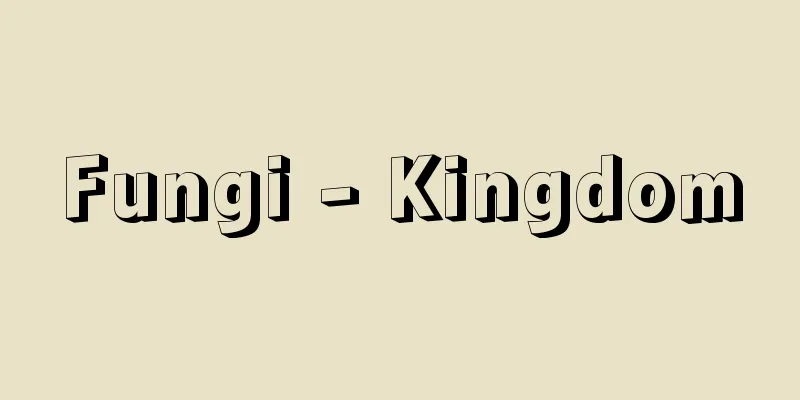Fungi - Kingdom

|
It is one of the three elements that make up the living world, along with the plant kingdom and the animal kingdom. Changes in the view of biology and the fungus kingdomIt has been common knowledge since ancient times that there are plants and animals in all living things. However, after the invention of the microscope and the discovery of groups of tiny organisms, the kingdom Protista or Microbes, which includes these organisms, was considered a third kingdom, and some even advocated a four- or five-kingdom theory, but this did not replace the common-sense dualism of life. For example, in Whittaker's 1969 five kingdom theory, the following five were listed: (1) the kingdom Monera (prokaryotic bacteria and blue-green algae), (2) the kingdom Protista (unicellular eukaryotic algae, protozoa, and some fungi such as the fungus Pseudomonas and Chytridiomycetes), (3) the kingdom Plantae (multicellular eukaryotic plants), (4) the kingdom Fungus (fungi in the narrow sense excluding (1) and (2) above), and (5) the kingdom Animalia (animals other than protozoa). In this classification, (1) and (2) are divided into two parts, one above the other, in the evolutionary stages from simple to complex body systems, and (3) to (5) are divided into three parts vertically, in the evolutionary stages following (2), and there is no uniformity in the overall classification method. In the classification of the kingdom of life, vertical phylogenetic classification, including origin and evolution, is important. (3) to (5) are the progress of the nutritional methods in the direction of photosynthesis, absorption, and digestion, respectively, and if this idea is applied to (1) and (2), it becomes as follows. Cyanobacteria and unicellular algae are a lineage of plants that perform oxygenic photosynthesis, protozoa are a lineage of animals that perform digestion, and the remaining are a lineage of fungi that perform absorption. In this way, the existing groups of life are organized into three phylogenetic groups, and the kingdom Mycota includes prokaryotic and eukaryotic fungi. This idea is supported by evolutionary and ecological facts and developed into the trinity of life. [Hironori Terakawa] The origins of the fungus kingdomAs a result of chemical evolution on the primordial Earth, a group of primitive organisms (prokaryotic single-celled organisms) appeared about 3.5 billion years ago and lived and evolved by absorbing primitive organic matter dissolved in the surrounding water. Later, in addition to this absorption function, photosynthetic functions developed and evolved into blue-green algae, the ancestors of plants. Over hundreds of millions of years, the absorbing single-celled organisms progressed to eukaryosis, and the process of predation and digestion was added to the absorption function, leading to the evolution of eukaryotic animals, and on the other hand, eukaryotic plants also evolved. Fungi inherited the nutritional method of absorption from the first group of primitive organisms. The subsequent evolution of these three lineages was the evolution of systems that made their characteristic nutritional methods even more effective. Thus, while plants live with their leaves spread out and animals live by moving, fungi live by burrowing into the substrate. [Hironori Terakawa] The importance of considering fungi as a part of the fungal kingdomProkaryotic and eukaryotic fungi in the kingdom Fungi are what we call bacteria and fungi, and bacteria are generally taught as not being included in fungi. Bacteria are also called bacteria, but bacteria also include blue-green algae (cyanobacteria). Furthermore, the commonly used term "microorganisms" includes not only fungi and bacteria, but also protozoa and algae. A correct view of nature cannot be obtained by distinguishing bacteria from fungi, or by confusing the view of life with bacteria and microorganisms. There was a reason why the living groups were differentiated into three. In order for substances essential to living organisms, especially carbon, to circulate smoothly through the living world, three groups are essential: plants as producers, animals as consumers, and fungi of the kingdom Fungi as reducers. Most of the carbon dioxide used by plants in photosynthesis is due to the reducing action of these fungi. If carbon dioxide on Earth is not replenished, it will be used up by plants in 250 to 300 years. The mechanism of material circulation has opened the way to infinitely use the finite substances on Earth, and this has guaranteed the prosperity of the living world for over three billion years. The above is the gist of the biological trinity. This view of ecosystem nature is indispensable as the background for all human activities. For this, it is important to establish the concept of fungi in the fungal kingdom. [Hironori Terakawa] "The Phylogenetic Evolution of Fungi" by Hironori Terakawa (1978, University of Tokyo Press) [Reference items] | |Source: Shogakukan Encyclopedia Nipponica About Encyclopedia Nipponica Information | Legend |
|
植物界、動物界とともに生物界を構成する3要素のうちの一つである。 生物観の変遷と菌界生物には植物と動物があるというのが古来の常識であった。しかし、顕微鏡が発明されて微小な生物群が発見されるようになってからは、それらを含む原生生物界または微生物界が第三の生物界として考えられ、さらに一部では、四界説、五界説が唱えられたが、常識的な生物二元論にかわることはできなかった。たとえば、1969年のウィッタカーの五界説では、次の五つがあげられた。(1)モネラ界(原核生物の細菌類と藍藻(らんそう)類)、(2)原生生物界(単細胞性真核生物の藻類、原生動物および菌類の一部であるネコブカビやサカゲツボカビの仲間)、(3)植物界(多細胞性の真核植物)、(4)菌類界(Fungus kingdom前記(1)と(2)を除く狭義の菌類)、(5)動物界(原生動物以外の動物)。この分類では、(1)と(2)は簡単な体制から複雑な体制へ進む進化段階で上下に二分し、(3)~(5)は(2)に続く進化段階を縦に三分していて、全体の区分法に統一性がない。生物界の分類には、起源と進化を含む縦方向の系統分類が重要である。(3)~(5)はそれぞれの栄養法が光合成、吸収、消化の方向に進んだものであるが、この考え方を(1)と(2)に適用すると次のようになる。藍藻類と単細胞性藻類は、酸素発生型光合成を行う植物類の系統であり、原生動物は消化を行う動物類の系統、残りのものは吸収を行う菌類の系統である。このように現存生物群を整理すると三つの系統群となり、菌界Mycotaには原核菌類と真核菌類が含まれる。この考え方は、進化学的および生態学的に裏づけされて、生物三元論に発展する。 [寺川博典] 菌界の成り立ち原始地球上での化学進化の結果として、約35億年前に誕生した原始生物(原核性単細胞体)群は、周囲の水中に溶けている原始有機物を吸収して生活と進化を行った。その後、この吸収機能に加えて光合成機能が発達したものが、植物類の祖先の藍藻として進化した。吸収を行っていた単細胞体は何億年もかかって真核性に進み、吸収機能に捕食消化という過程が付け加わって真核性の動物類が進化し、他方では真核性の植物類も進化した。最初の原始生物群の吸収という栄養法を受け継いだのが菌類である。これらの三つの系統群のその後の進化は、それぞれの特徴的栄養法をいっそう効果的にするような体制の進化であった。こうして、植物類は葉を広げて生活し、動物類は動いて生活するのに対して、菌類は基物に潜って生活する体制となった。 [寺川博典] 菌界の菌類という見方の重要性菌界の原核菌類と真核菌類は、いわゆる細菌類と菌類であって、一般に細菌類は菌類に含まれないものとして教えられている。また、細菌類はバクテリアともいわれるが、バクテリアには藍藻類(シアノバクテリア)も含まれる。さらに、普通に使われる「微生物」は菌類や細菌類のほかに原生動物や藻類も含む。細菌類を菌類と区別したり、バクテリア、微生物といった混乱した生物観からは正しい自然観は得られない。生物群が三つに分化したのは、それなりの理由があった。生物体になくてはならない物質、とくに炭素が滞りなく生物界を循環するには、生産者としての植物類、消費者としての動物類、および還元者としての菌界の菌類の三者が不可欠である。植物類が光合成に使用する二酸化炭素の大半は、この菌類の還元作用によっている。地球上にある二酸化炭素は、補給されなければ250~300年で植物類によって使い尽くされる。物質循環という仕組みは地球上有限の物質を無限に使用する道を開いたものであり、これによって三十数億年にわたる生物界の繁栄が保証されてきた。以上は生物三元論の要旨である。この生態系自然観は、人間のあらゆる活動の背景として欠かすことはできない。それには菌界の菌類という概念の確立が重要である。 [寺川博典] 『寺川博典著『菌類の系統進化』(1978・東京大学出版会)』 [参照項目] | |出典 小学館 日本大百科全書(ニッポニカ)日本大百科全書(ニッポニカ)について 情報 | 凡例 |
Recommend
Jay (Kakesu) - Jay (English spelling)
A passerine bird of the Corvidae family (illustrat...
Exalbuminous seed (English spelling)
…Even if nutrients are temporarily stored in the ...
te Winkel, LA (English spelling) teWinkelLA
…At the beginning of the 19th century, Matthijs S...
X-ray absorptiometry
...X-ray fluorescence analysis is the same analyt...
pleroma (English spelling)
…He founded the Valentinian sect and had a great ...
Emihi, FP - Emihi
...Depending on the amount of sample handled, che...
Lomatogonium carinthiacum (English name) Lomatogonium carinthiacum
...Inusenburi (O. diluta (Turcz.) Ledeb.var. tosa...
Working People's Party
…After liberation in August 1945, he demanded the...
Judicial state - Shihokokka
Under the principle of separation of powers, it r...
Exchange - exchange
A market organization or facility where items, ti...
Meade, GG (English spelling) MeadeGG
…It took place near Gettysburg, Pennsylvania, fro...
Bāo tóu (English spelling)
A city in the central part of the Inner Mongolia A...
Fossil Zone - Kasekitai
A geological division characterized by the fossil...
Field crops - Field cultivation
〘 noun 〙 The act of cultivating fields and produci...
Gregor Johann Mendel
Austrian monk and biologist. Founder of modern ge...









